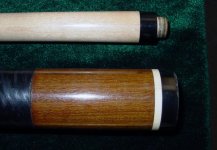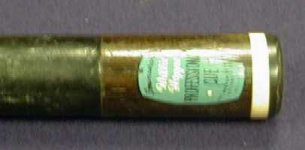I notice that in dating the Hoppe cues that the labels tend to aide in dating them. What about certain material characteristics? I know war time cues used a black joint, metal pin because brass was restricted. What about the ivory rings? I have seen two Hoppe ring sizes in Titlist cues... the fat 3/8 ring and a thinner 3/16 ring as shown in the two examples.
Note the one forearm has the Bullseye stamp...
JV
Note the one forearm has the Bullseye stamp...
JV


